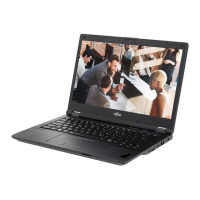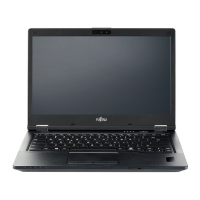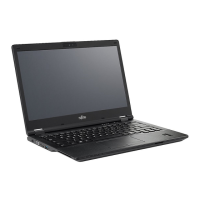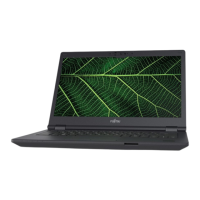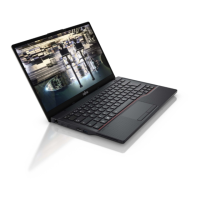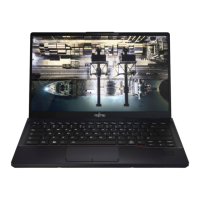Why does my Fujitsu LIFEBOOK E554 Laptop beep when battery is low?
- NNoah YangSep 10, 2025
If your Fujitsu Laptop beeps every few seconds, it means the battery is almost dead. You should charge the battery.
Why does my Fujitsu LIFEBOOK E554 Laptop beep when battery is low?
If your Fujitsu Laptop beeps every few seconds, it means the battery is almost dead. You should charge the battery.
How to resolve 'Operating system not found' error on Fujitsu LIFEBOOK E554 Laptop?
If you receive the error message 'Operating system not found' on your Fujitsu Laptop, check in the BIOS Setup whether your hard disk has been set correctly and ensure that the operating system is installed on the corresponding drive.
What does 'Extended memory failed' mean on Fujitsu LIFEBOOK E554?
If you receive the error message 'Extended memory failed at offset: xxxx Failing Bits: zzzz zzzz' on your Fujitsu Laptop, check whether the additional memory module has been inserted correctly.
How to resolve 'Failure Fixed Disk n' error on Fujitsu LIFEBOOK E554?
If you receive the error message 'Failure Fixed Disk n' on your Fujitsu Laptop, start the BIOS Setup (Primary Master submenu) and select the correct settings for the hard disk drive.
How to contact Fujitsu for technical assistance and product support.
Guidance on keeping system drivers and software updated using FSDM.
Identifies front-facing ports and controls on the notebook.
Details the ports located on the left side of the notebook.
Details the ports located on the right side of the notebook.
Identifies ports and compartments located on the bottom of the notebook.
General safety guidelines to follow when using the notebook.
Specific safety precautions for devices with wireless LAN and Bluetooth.
Information on reducing power consumption and extending battery life.
Guidelines and tips for safely transporting and using the notebook while traveling.
Steps for unpacking and inspecting the notebook for transport damage.
Recommendations for selecting a suitable and safe place to set up the notebook.
Instructions on how to connect the notebook to a power source using the AC adapter.
Steps for switching on the notebook for the first time and initial setup.
Explanation of the various LEDs and indicators on the notebook.
Procedures for powering the notebook on and off correctly.
Details on keyboard layout, special keys, and character input.
Explains useful function key combinations for various operations.
Instructions on using the touchpad for cursor control and selection.
Details about the LCD display, pixel definitions, and background lighting.
Guidance on battery care, charging, and service life.
Information on installing and removing modular bay devices like drives.
Instructions for handling and using the CD/DVD drive.
How to utilize energy saving modes to conserve power.
Details on wireless connectivity options and their usage.
Information on connecting the notebook to a port replicator for extended connectivity.
Steps to set up and use the fingerprint sensor for security.
Setting supervisor and user passwords for BIOS access.
Information on enabling/disabling the TPM for enhanced security.
Guide to using the smart card reader for authentication and security.
Steps to connect monitors via VGA, Display Port, or DVI-D.
Guide to connecting various devices via USB ports.
Procedure for safely disconnecting USB and eSATA devices.
Instructions for connecting external microphones and headphones.
Safety precautions and steps before removing or changing internal components.
Instructions for removing and installing memory modules.
Procedures for removing and installing the hard disk drive.
How to access and navigate the BIOS Setup Utility.
Options for saving changes, discarding them, or loading defaults.
Initial steps to take when a fault occurs.
Troubleshooting steps for blank or hard-to-read LCD screens.
Solutions for blank or unstable external monitor displays.
Troubleshooting for startup failures and system freezes.
Explanations and solutions for common BIOS error messages.
Details on ambient conditions, dimensions, weight, and memory.
Technical details about the wireless LAN capabilities.
Safety instructions related to power adapters and battery replacement.
Information on FCC, IC, ENERGY STAR, and declarations of conformity.
Details on FCC compliance and radio frequency exposure limits.
Guide to setting up and using wireless LAN in different modes.
Steps to create system backups and perform recovery.
Procedures for recovering the system from hard drive issues.
How to find and download the latest system drivers.
| Optical drive | DVD Super Multi drive |
|---|---|
| Display | 15.6" HD (1366 x 768) or Full HD (1920 x 1080) anti-glare |
| Weight | 2.3 kg (5.07 lbs) |
| Ports | Ethernet (RJ-45) |
| Card Reader | SD/SDHC/SDXC |
| Wireless | Bluetooth 4.0 |
| Operating System | Windows 10 Pro, Windows 8.1 Pro, Windows 7 Professional |


